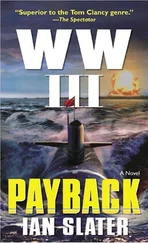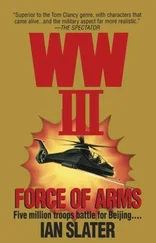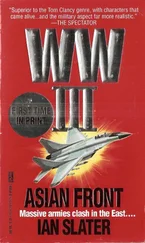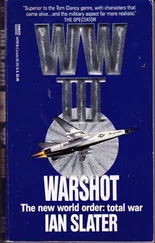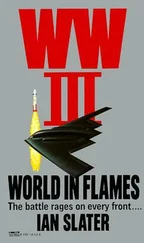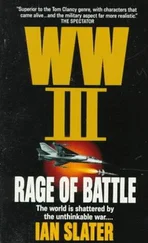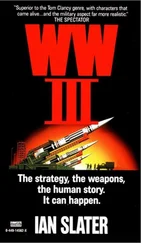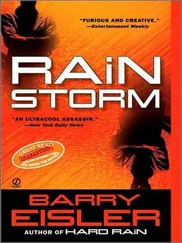The padre, a good friend of the battle group commander, tried to soften the blow. “God works in mysterious ways, his wonders to perform,” he reminded the admiral.
“Is that so?” Crowley retorted churlishly. “Where was he when that kamikaze holed my roof?”
The padre assured the admiral that the Almighty had a plan.
“Well, I’m damned if I can discern it, Padre,” Crowley said, his tone softening for the sake of friendship, if not because of religious belief.
The rain of cruise missiles on Penghu brought shock and awesome devastation, the huge billows of copper-red smoke rising, reeking of burning Avgas and atomized fish fertilizer from the once picturesque stony-bordered farms, the clouds of war obscuring the island clearly visible to satellite reconnaissance. The problem was, Typhoon Jane’s residual tail winds had “increased the CEP,” as the Pentagon put it.
“In English, please,” Eleanor Prenty demanded.
“Circular error probable, ma’am. It means the diameter centering on the target within which there is a fifty percent chance of hitting.”
“Error probable?” said Eleanor. “My God, you’re telling me that they didn’t hit Penghu?”
“No, our missiles did hit Penghu. No question about—”
“But not the runway and all the radars?”
“No, ma’am. I mean that’s right, you’re correct. We—”
“Give me a percentage, Commander. What percent did you hit? Eighty? Sixty?”
“ ’Bout forty to fifty.”
“What’s the Encino ’s load-out?” she asked, knowing that sometimes the subs carried extra cruise missiles, housing them in the torpedo racks.
The Pentagon man didn’t know if the twelve Tomahawks were the Encino ’s full load of cruise missiles or whether there were some in reserve.
“Well, find out,” she told him abruptly.
“Yes, ma’am!”
“Use my phone.”
It was very highly classified information, and the Pentagon messenger, albeit a commander, had to have written authority from the Chief of Naval Operations to be given one of America’s launch platform’s precise “load-out.”
Eleanor Prenty waited impatiently. If Encino didn’t have reserve Tomahawks, then someone else would have to be tasked to finish what Encino had begun and to pulverize the Penghu runway before the PLA could use it as a base from which clandestine attacks could be launched against Taiwan — even during an official cease-fire that the Secretary of State was hastily trying to broker between Beijing and Taipei, both Chinese capitals sticking firmly to their positions that the other one had reopened hostilities.
The commander from the Pentagon had the answer to Eleanor’s question twenty minutes later. SSN Encino ’s multiple launch, as ordered by the President, had exhausted the submarine’s load-out supply of twelve Tomahawks.
The President didn’t hesitate. “Draw up orders,” he told the Chief of Naval Operations, “for McCain ’s battle group to take out that runway.”
“How about vertical launch from the Aegis cruisers?” asked Eleanor. “ McCain ’s pretty badly—”
“No.” The President was adamant. “It’s important politically as well as for the Navy’s morale — which is the lowest I’ve ever seen — to have McCain do it. Have the carrier’s air wing launch the attack. Stand-off weapons. If we can take Makung out as their forward air base, we’ll have a lot more leverage to force Beijing to the table.”
“Makung?” asked Eleanor.
“Penghu’s city. Where the runway is.”
“Oh,” said Eleanor. “Yes, of course. Mr. President, do you think Beijing’s got anything to do with this sub attacking us in the Northwest?”
The President had obviously thought a lot about it, as he had about the myriad fronts going on in the war, clandestine and overt, all over the world as the U.S. struggled to keep the upper hand. “I don’t think so, Eleanor. Nor do the Joint Chiefs. It seems more like a terrorist group to me. Trouble is, we Americans have — let’s face it — a lot of difficulty accepting the fact that a bunch of Muslims could develop a weapons platform so quiet, so able to pierce our defenses — like this midget sub the Navy’s hydrofoils are now finally closing in on.”
“Finally” seemed a bit rich to Eleanor. Admittedly, it had felt like months and months dealing with the Northwest attack, along with everything else, but crises always seemed longer at the time. In fact, it had been much shorter, and the Navy had done darned well to get the hydrofoils on their way, because the new craft had barely finished sea trials.
“Problem is,” the President said, “we think of Muslims, we think of Iraq, Iran, Afghanistan. Desert and oil.” The Chief Executive paused. “Had you ever imagined Arabs as submariners?”
“No. Well, I knew some Russian submariners who were Muslim, but no, not further than that.”
As Freeman and Aussie neared the bow of the sub, the snorkel pipe stopping then beginning to inch up again — its slow ascent no doubt an attempt to keep its rasping to a minimum — the two wondered if the sub’s sonar had picked up the noise of their paddling. The fogbound sea was considerably calmer now than when they had shot at the sub much earlier that day. Or was the sub’s scope sliding up for a visual check? But what was there to see in the fog, besides the Skate ’s dying firelight?
Aussie glimpsed the Petrel , her stern’s hydraulic arm silhouetted against the oil slick’s fire. Having heard the rasping of the sub’s snorkel being raised, Frank Hall had no doubt decided to move the oceanographic vessel in quickly to pick up as many Skate survivors as possible.
Freeman, meanwhile, reached for the waterproof matches in his vest and flushed. It was his usual physiological reaction upon realizing he’d uncharacteristically forgotten a vital detail. This time it was the short fuse on each of the fist-sized LOSHOK packs he’d given Aussie, which would allow only two seconds. No way you could duct-tape, light the fuse, and get clear. There was no time to convey his concern to Aussie other than by speaking. And they were only ten feet from the sub’s starboard fairing, which Aussie would have to board to place the charge. “Cut the second pack’s fuse and tape it to the first,” the general whispered hoarsely. “That’ll give us more time.”
Four seconds, Aussie thought, to tape and run.
Their Zodiac bumped gently against the sub’s side.
A beam of light struck out from Petrel ’s foredeck toward the Skate ’s burning oil spill, looking quickly for survivors. Aussie and Freeman heard a dull thud, then saw a head appear above the sub’s stubby conning tower, followed by a quick order in a language neither Aussie nor the general understood. Then they heard another, more excited, voice, and saw a.50 caliber barrel poking up from the interior of the conning tower and sticking straight out in the direction of the Skate . The gunner appeared next, and then whoever was giving the orders, either the sub’s captain or the officer of the deck.
Good God, Freeman thought. The bastards were going to shoot the Coast Guard survivors as well as the men on the Petrel who were trying to rescue them.
A long, ragged flame spat into the fog from Freeman’s HK, the 9mm rounds chopping into the sub gunner’s head and into the officer’s right shoulder. But the officer managed to swing the.50 around and squeeze off a loud burst. A bullet struck Freeman in the chest, knocking him out of the Zodiac as Aussie, already on the sub’s fairing below the conning tower, plunged his K-bar into the officer. The officer grabbed at his throat in a vain effort to stop the pulsing jets of blood that showered Aussie’s face, then the officer’s body crumpled noisily, the wooden stock of the.50 falling back with a whack against the sub’s collar.
Читать дальше


